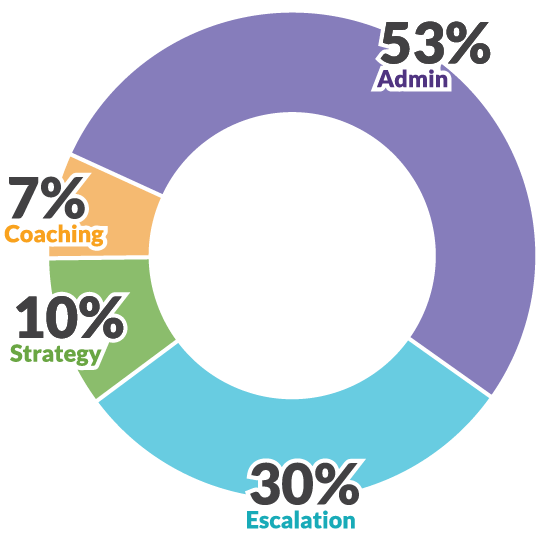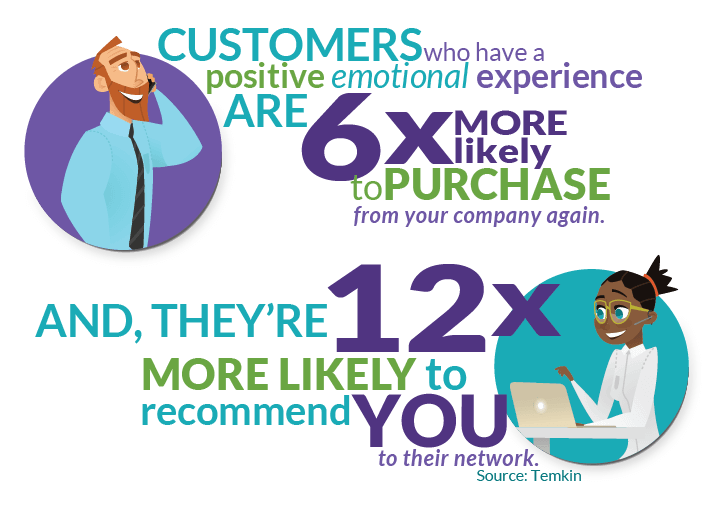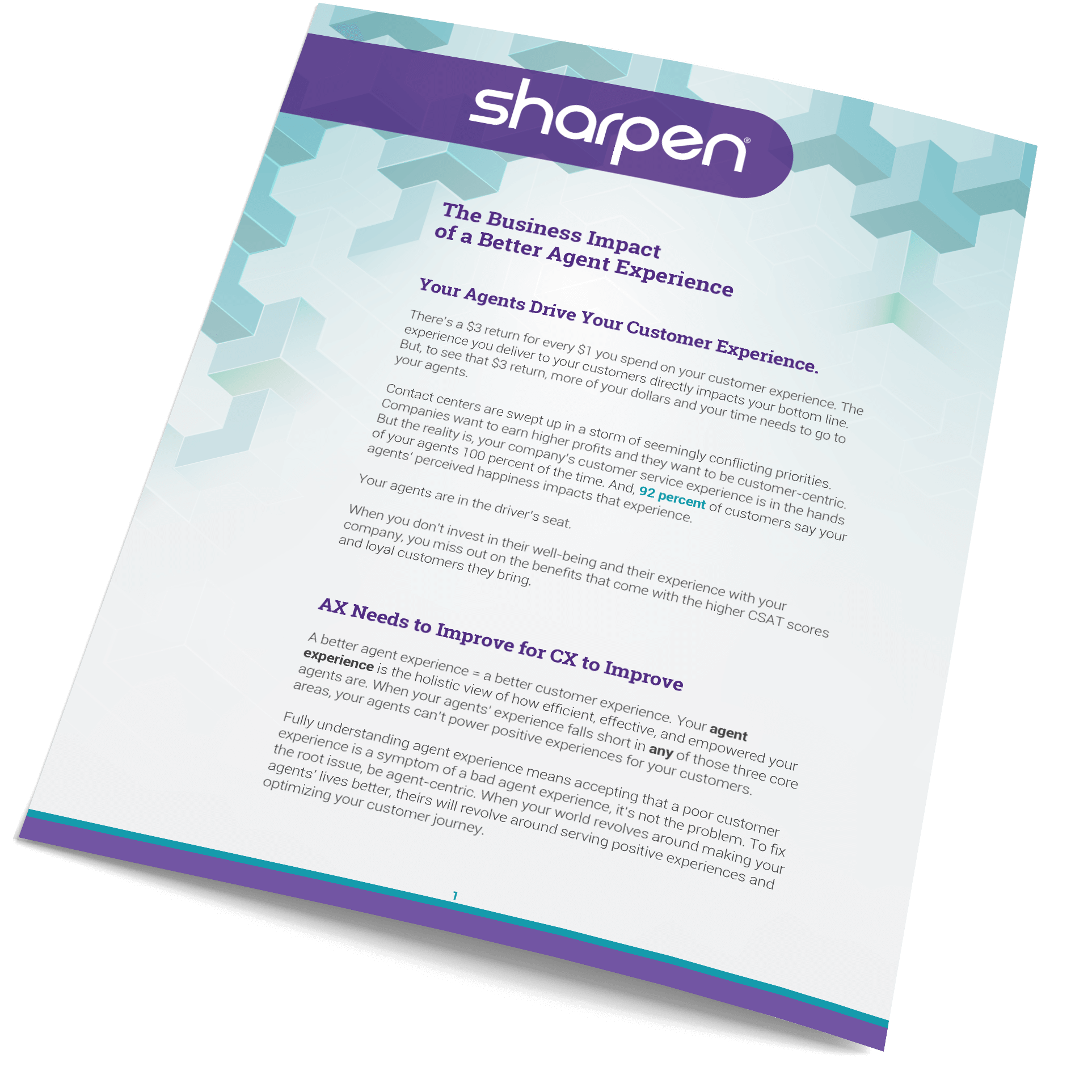
10 Statistics (and Action Items) to Inspire Your Next Steps in Customer Service Training
A good manager is a good coach. Gallup found companies who strategically invest in employee development see 11% greater profitability.
Yet too many customer service leaders are bogged down by other tasks to actually dedicate time to coaching and training their teams. Turns out managers like you only have 7% of their time available for deep work, like training and coaching. The rest of their time is consumed by a boatload of meetings, emails and escalations.

And while meetings and escalations are important (in moderation), your biggest value comes from the small amount of time you spend on meaningful work. Just think, what if you could spend your time coaching and empowering agents to handle customer issues on their own, instead of handing them off to you? You’d free up more of your time for meaningful work, and you’d prevent your customers (and agents) from boiling over.
You control your agents’ experience on the job, and your agents control your customer’s service experience. To take your customer service to the next level, you need a customer service training strategy that fits into your schedule.
“Delivering great customer service has many contributing factors, but customer service training lies at the heart of this challenge. Without proper customer service representative training and enablement, reps don’t have the knowledge and skills they need to provide service that sets them apart from their competitors.”
– Lessonly
Here are 10 statistics to inspire your customer service training, along with actionable tips to take back your time and put it toward high-value work, like coaching your team.
1. There’s a $3 return for every $1 a company spends on a better customer experience. (Avanade)
Why it matters:
Let’s set this straight. Investing in your customer experience always pays off. And your agents have arguably the biggest impact on your customer experience. It makes sense, then, that investing in your agents is the gateway to a better customer experience.
What you can do about it:
Prioritize customer service training and development in your call center budget, so you can invest in your agents. Set aside resources (both money and time) to coach and train your supervisors and agents regularly. There’s no line item more important than your people.
[Download Now] Need help getting buy-in? Share these nine statistics with your boss to build a business case for a better agent experience.
2. A big company can save upward of $60 million annually if managers can move teams to the top quartile of engagement. (Gallup)
Why it matters:
There’s a direct link between employee training and development and employee engagement. According to Quantum Workplace, 79% of employees who had a formal development program were engaged. The more you grow and engage your agents, the faster you shift from a cost center to a profit center.
What you can do about it:
Shift your mindset from every-now-and-then training to continuous coaching. Build actionable and relevant feedback into your daily workflow. Meet with agents (or your supervisors) 1:1 regularly. Create a coaching culture that supports and engages your team.
“There is a virtuous cycle between productivity and people: Higher levels of productivity allow society to reinvest in human capital (most obviously, though not exclusively, via higher wages), and smart investments result in higher labor productivity.”
– Eric Garton for HBR
3. Customer service professionals trained in empathy are almost 2x as likely to be high performers. (Salesforce)
Why it matters:
Last year was devoid of any ounce of normalcy, and it took a toll on everyone. While employee engagement trended up, for the first time ever, well-being plummeted in the opposite direction. People are craving empathy to combat all the stress and worry that’s consumed us. Your customer service team needs training rooted in compassion and empathy to carve a path forward.
What you can do about it:
Empower your team to be flexible with customers. Encourage agents to take the extra 30 seconds during an interaction to understand each customer’s pain. The occasional high handle times don’t matter when customers are happy and have a positive emotional experience with your brand.
4. Some 63% of agents say it’s difficult to balance speed and quality when serving customers. (Salesforce)
Why it matters:
This statistic gives you a focal point for future training. Two-thirds of agents think both speed and quality matter to customer service, but they struggle to manage both.
What you can do about it:
Tip the scales in your agents’ favor. Use behavioral customer data and gather trends from past interactions to help agents prioritize what matters most to your customers. Set the right goals and expectations with your team, then coach and train them often to reach those goals.
[Read Next] Customer service data: the nucleus of your call center
5. According to learning & development leaders across the globe, the top two skills to prioritize this year (in every country) are resilience and digital fluency. (LinkedIn)
Why it matters:
Some 86% of customers now expect conversations with agents to move seamlessly between channels. As companies invest more in digital projects, your training needs to mirror that investment. Agents need to be fully equipped to handle digital interactions.
What you can do about it:
Train agents to handle multiple channels, like phone, SMS, chat, and email. You use different skillsets to communicate on different channels, so stock your knowledge base with scripts to help agents learn the ins and outs of each. And, wait times look different across channels, too. Create SLAs unique to each channel, so your agents always have the right expectations.
6. Studies show shorter training modules improve information retention by 20%. (Dresden University of Technology)
Why it matters:
The average employee faces 56 interruptions per day and only spends an average of three minutes working before switching tasks. Do you think your agents will actually retain the information you throw at them in a classroom-style training that lasts eight hours a day?
What you can do about it:
Slip in-line feedback and microlearning into your performance management plan. Pair more in-depth training with supplemental materials like YouTube courses and fast, self-guided lessons. Offer up bite-sized training modules so your agents can digest new concepts before their internal timer tells them to switch tasks.
7. Coaching that happens immediately after interactions, sometimes called integrated coaching, can improve team performance by 12%. And, the best managers spend 75% of their time on in-the-moment coaching. (HBR)
Why it matters:
Managers who carve out more time to coach their team see results in the performance of their people. And, coaching fast with relevant feedback after an interaction is more effective than hanging on to feedback and bringing it up a month later in a 1:1.
What you can do about it:
Use in-line customer service training and coaching so your agents have the context to understand constructive criticism on their interactions. Highlight key pieces of their calls or transcripts to show them where their tone shifted, where they used the wrong language, or where they could have pulled in customer history to inform the conversation. Then, agents learn where to improve and can make changes ahead of their next interaction.
8. Only 21% of employees feel like they have the performance management (i.e. feedback, access to analytics, and clear expectations) they need to do outstanding work. (Gallup)
Why it matters:
When you don’t have a performance management strategy in your call center, your agents can’t provide outstanding service. Your agents need to know and understand their goals, their performance expectations and their impact on the entire customer experience.
What you can do about it:
Day-to-day performance management needs to work in tandem with your customer service training and coaching. Performance drives ownership and coaching drives development and change. Create a performance management strategy and use tangible data to keep agents informed on how they’re doing. Then, pair that with relevant coaching to amplify positive results.
[Read Next] The ROI of performance management
9. Companies with internal mobility had an almost two-year longer retention rate than those without it. (LinkedIn)
Why it matters:
When you upskill your employees and help them develop in their careers, they stay longer. That shrinks the cost of turnover in your call center and it means more tenured agents are available to help customers. An agent who’s been with your company for five years harbors institutional knowledge that a fresh hire doesn’t. Of course, new hires can be taught, and the right ones make a standout impact on your customer service. But ramping agents to full productivity takes time – something so many managers lack.
What you can do about it:
Build development opportunities into your training strategy. Don’t just offer support for how your agents can get better right now. Play the long game, too. Create clear paths to promotion or advancement for your team. Then, work with them 1:1 to develop the skills to get there. They’ll feel valued and stick around, passing their happiness and knowledge off to your customers.
10. Some 86% of customer service professionals think customers are smarter and more informed now than ever before. (HubSpot)
Why it matters:
Smarter customers need more knowledgeable agents. Back in 2018, the World Economic Forum published a report that mentioned the upskilling imperative. As more processes become automated, workers need to learn new (and more) skills to tackle the fresh complexities in their roles. And now, upskilling employees is even more critical since Covid-19 accelerated digital transformations and forced customers to increase their digital fluency, too.
What you can do about it:
Upskill your customer service workforce. Don’t just fill out a few agent scorecards and call it done. Identify the core competencies your agents need to succeed in delivering good customer service now and five years from now. Then, address each competency in your training and development sessions. The success of your customer service team (and your customers) is up to you.



